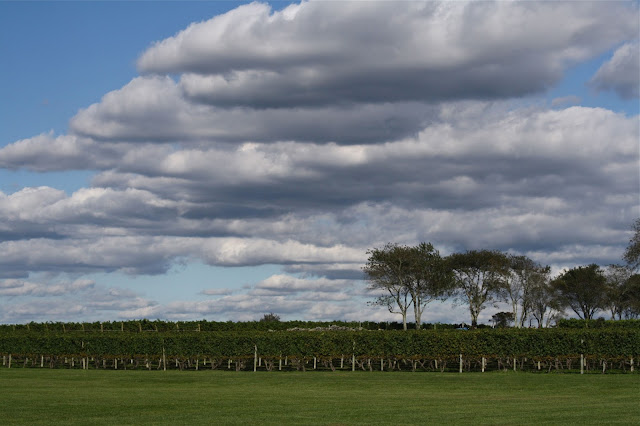"All good things come to those who wait." Labor Day may have come and gone, but there are still at least three weeks of summer left! As this season comes to an end, hot, humid days and nights are replaced the much anticipated cooler, crisp ones. The return of perfect running and sleeping weather here in the midwest makes me giddy. Almost as giddy as what the addition of an Argentinian parsley-based sauce did to the marinated, grilled flank steaks I served this past weekend. I was completely taken aback by the deliciousness of the chimichurri sauce. Where had it been all my life? This intensely flavored fresh sauce was definitely a game changer. Seriously. From this point forward, no grilled steak, particularly this marinated flank steak, shall ever be served without it.
While food historians agree chimichurri sauce was the likely creation of cowboys looking to add flavor to fire-roasted meats, there is only speculation regarding the origin of this sauce's name. Some claim it morphed from name 'Jimmy's curry sauce' with credit being given to Jimmy McCurry, an Irish meat merchant and freedom fighter, alleged to have fought for Argentine Independence in the early 1800s. Others say Basque settlers arriving in Argentina in the 19th century named it 'tximitxurri' which loosely translated means 'a mixture of several things in no particular order'.
The chimichurri sauce(s) served today more than likely variations of the one(s) served centuries ago due to Spanish, Italian, French and English culinary influences. Almost all chimichurri sauces have (flat leaf) parsley, garlic and olive oil as its' core ingredients. Oregano, either in fresh or dried form, is the most common herb added to the sauce. Red wine vinegar, red pepper flakes, salt, and lime juice are the other ingredients most frequently used to create this tangy, bursting with flavor herb-based condiment. The version I made, coming from the cookbook 'Tartine All Day: Modern Recipes for the Home Cook" was made with flat leaf parsley, basil, garlic cloves, capers, kosher salt, and olive oil. The only change I made to the recipe was using a food processor instead of chopping the fresh herbs.
As enamored as everyone was with surprise addition of the Chimichurri Sauce to the Grilled Flank Steak, the marinated flank steak received more than its' fair share of accolades. Allowing the flank steak to marinate overnight definitely helped to ensure the marinade imparted the most flavor. The recipe for the marinade came from the decades old Bon Appetit recipe I had managed to hang on to over the years. And honestly, it may be the best flank steak marinade recipe ever created. Soy sauce, olive oil, honey, garlic cloves, fresh rosemary, black pepper, and kosher salt work together harmoniously to create one of the most flavorful flank steaks you will ever grill and serve. Scout's honor. Two equally critical factors to this recipe are the grilling time and resting time. Four to five minutes per side on a hot grill is all it takes to achieve medium-rare flank steak perfection. For thicker cuts of flank steak use the five minute guideline. Allow the grilled flank steak to rest at least 5 (but up to 10) minutes before cutting across grain in 1/4 inch slices to ensure optimal juiciness.
Forget grilling any other kind of steak at your next gathering. I promise if you make and serve this Grilled Flank Steak with Chimichurri Sauce, none of your friends and family will be asking or wondering or asking why you didn't serve your usual 'grilled' meat. Rather they will be asking why you were holding out on them. Just consider telling your newly enlightened and euphoric guests 'Good things come to those who wait.'
Grilled Flank Steak with Chimichurri Sauce (Slight adaptations to the Flank Steak recipe from Bon Appetit, September 1995 and to the Chimichurri Sauce from Tartine All Day: Modern Recipes for the Home Cook by Elizabeth Prueitt)
Serves 4 to 6
Ingredients
Flank Steak*
1/2 cup soy sauce
1/2 cup olive oil
4 1/2 Tablespoons honey
6 large garlic cloves, minced
3 Tablespoons chopped fresh rosemary (or 1 Tablespoon dried rosemary)
1 1/2 Tablespoons coarsely ground black pepper
1 1/2 teaspoons kosher salt
2 to 2 1/4 pound piece of flank steak
*I doubled all of the ingredients.
Chimichurri Sauce
1/2 cup (10g) flat-leaf parsley leaves
2 Tablespoons chopped tender fresh herbs (e.g., basil, oregano, chervil, or cilantro)
1/2 cup (120 ml) olive oil, plus more if needed
2 garlic cloves
1 Tablespoon salt-packed capers, rinsed
Pinch of sea salt
Directions
Flank Steak
1. In a gallon sized zip lock bag, mix together the soy sauce, olive oil, honey, garlic cloves, rosemary, pepper and salt.
2. Add the flank steak. Seal the ziplock bag tightly and allow the mixture to evenly coat both sides of the flank steak.
3. Place in the refrigerator and chill at least 6 hours or overnight, turning occasionally. Highly recommend marinating overnight.
4. Prepare grill bringing the heat to a medium-high temperature.
5. Remove meat from the marinade. Grill steak 4 to 5 minutes per side, depending on the thickness of the flank steak, for a medium-rare finish or until desired level of doneness.
6. Transfer steak to a cutting board. Allow to rest at least 5 -10 minutes before slicing. Cut flank steak across the grain into 1/4 inch strips. Arrange on platter. Drizzle with the Chimichurri Sauce.
Chimichurri Sauce
1. Place parsley, fresh herb of choice (I used basil), garlic and capers in a small food processor. Pulse until mixture is finely chopped.
2. Transfer mixture to a small bowl. Pour in olive oil and pinch of sea salt. Stir to combine.
3. Serve immediately or store, tightly covered in the refrigerator for up to 5 days. If stored in the refrigerator, remove at least 30 minutes before serving.
4. Drizzle Chimichurri Sauce over grilled flank steak. Serve extra sauce on the side.
Rocky Mountain National Park, September 2016





























































